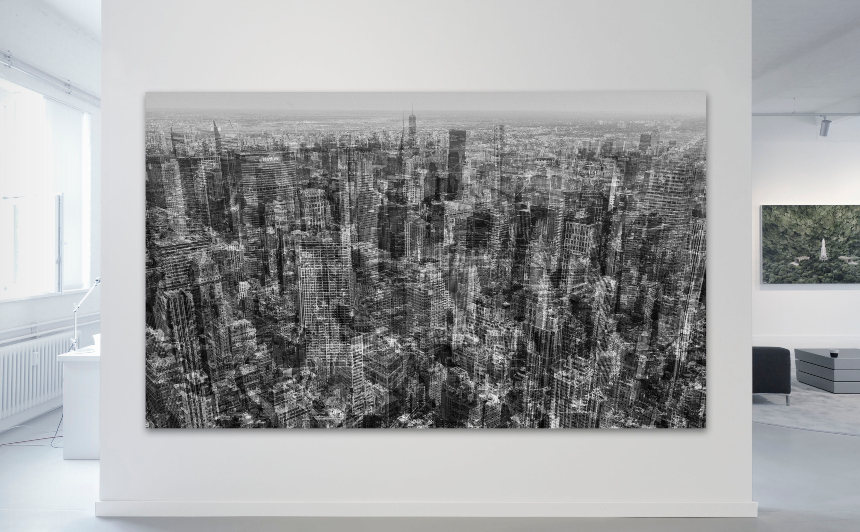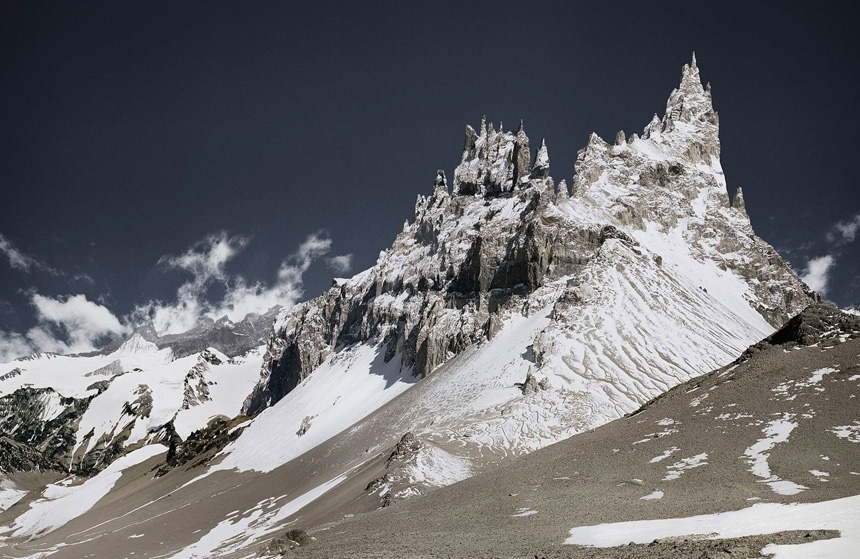Michael Najjar or the Financial Crisis as «Gesamtkunstwerk»
No other artist captures the dimensions of financial markets as compellingly as Michael Najjar in his series high altitude, arguably the first artistic interpretation to ever tackle this subject.
The jagged rock and mountain formations in the works of German artist Michael Najjar possess an eerie yet captivating quality. Their visual radicalism mesmerizes viewers, drawing their gaze to images that blend reality with simulation.
In fact, these snow-covered mountain ranges are not entirely real – they do not exist as depicted. Nevertheless, they are based on landscapes in Argentina, centered around Mount Aconcagua, the highest peak in the world outside the Himalayas. The approximately 360 photographs were taken during a three-week trekking expedition form the foundation of Najjar’s epic series.
Early Encounters With «Telematic Society»

(Michael Najjar’s studio, Berlin)
Although high altitude was created between 2008 and 2010, it has lost none of its captivating power, especially considering the physical toll required for its realization and the conceptual depth behind its execution.
Najjar, now 58 and based in Berlin, was among the first artists in the late 1980s to embrace conceptual work inspired by emerging media formats combining photography, video, and computer graphics. Born in Landau, he moved to (West) Berlin to study at the Bildo Academy, where he was influenced by media theorist Vilém Flusser and philosopher Paul Virilio. There, he made his initial experiences with the «telematic society».
«It was the symbiosis of reality and the hybrid,» Najjar recalls during an interview with finews.art at his Berlin studio.
Interestingly, the academy not only focused on artistic concepts but also emphasized physical fitness. Najjar took a course in the Far-Eastern martial art of Kung Fu, where he pushed his physical limits – an experience that, unbeknownst to him at the time, would benefit him during the high altitude project. Over the years, Najjar gained recognition as a conceptual artist with large-format photographs and digital edits, focusing on the interplay between nature and technology, or between science and the emotional vibrancy of life.
Unprecedented Quantum Leaps
Najjar achieved international acclaim with his oversized photo series netropolis, which began in 2003 and continues to evolve. Inspired by Fritz Lang’s 1926 film «Metropolis», Najjar layered black-and-white cityscapes from various angles to create reimagined portrayals of metropolises.

(Installation view Michael Najjar, netropolis | new york | 2016)
As Najjar explains, his art has always been about incorporating physical experiences into his creative process. At the dawn of the 21st century, as technology made quantum leaps and globalization ushered in unprecedented paradigms, Najjar became increasingly fascinated by global financial markets, as they combined the symbiosis of technology and globalization in an almost apodictic way. «At the same time, this creates a parallel world in which our material system dissolves into the virtual – it dematerializes.»
Driven by this perspective, Najjar opened an account with an online bank and began trading securities. He was most intrigued by the emotional aspects of trading – the thrill of managing risk, which could lead to complete success or total failure. He likened this emotional rollercoaster to the perilous dynamics of high-altitude mountaineering, where oxygen (or money) is essential for survival.
Reaching the Summit on the Second Attempt

(Michael Najjar, dow jones 80-09, 2009)
After months of preparation, Najjar set off in January 2009 with a friend, mountain guides, and porters to scale the nearly 7,000-meter-high Aconcagua in Argentina. The expedition required gradual acclimatization to thinner air, with the group stopping at two camps along the way. Najjar captured dozens of images of the increasingly barren yet striking landscape, though the extreme cold – temperatures below -30°C – made it progressively difficult to operate the camera.
«We knew that the biggest challenge was the final 1,000 meters of altitude,» recalls Najjar, where his expedition colleague was unable to make any further progress under the strain, so the ascent was called off on the advice of the mountain guide. In the camp at 6,000 meters, however, Najjar did not want to admit to himself that his project had failed. In short, he was not prepared to give up his belief in the success of the trekking tour he had planned for months. He managed to persuade a second guide to attempt another ascent to the top the next day.
That was on 29 January 2009. «With every step closer to the summit, the feeling of FOMO grew, analogous to the madness, so to speak, that haunts some speculators on the stock market,» says Najjar. The «fear of missing out», «it was an inner euphoria that outweighed the almost unbearable physical exertion, whereby I now benefited from the body control I had gained from my earlier Kung Fu training,» Najjar recalls of the last kilometer to the expedition's crowning moment at 2.25 pm, when he actually stood on the summit of Aconcagua.
Ready to Jump Into the Depths
As it turned out later, the two men were the two highest people in the world at the time, as no one was able to climb the 8,000-meter peaks in the Himalayas at that time of year for meteorological reasons.

(Michael Najjar, dax 80-09, 2009)
While Najjar and his guide spent only about 30 minutes at the top, a whole life was revealed to him during this time, a life that had a previously unimaginable fulfillment. «For a moment, I was ready to simply jump into the depths, because everything had been achieved, so to speak, and the hardships I had endured had made the greatest possible sense,» recalls Najjar.
But then something else happened that prevented him from jumping or falling into the depths: A long-haul Swiss airplane flew directly over the heads of the two mountaineers. «The plane seemed close enough to touch. And that's when I realised," explains Najjar looking back,» that my next project had to go one step further, so it had to be in outer space.» Although the descent turned out to be extremely dangerous because the body and soul began to fail after reaching the goal, the two men made it back to the camp at 6,000 meters and finally all the way back to civilization.
In the following months, Najjar painstakingly edited his photographs, blending the visual structures of the Argentine mountains with the charts of various stock indices (Dow Jones, DAX, Nikkei, RTS, Hang Seng, etc.) of the past 20 to 30 years.
Lehman Brothers Share Price
By embedding and reproducing them in the processed mountain images, share price movements take on a new significance, making the abstract nature of the global financial system at least virtually tangible. While the economy used to be based on the exchange of goods and commodities, since the dawn of the 21st century at the latest, the focus has shifted to huge amounts of data that can be stored thanks to technology. What is remarkable here, as Najjar emphasizes several times in the interview, is that the financial system developed linearly over decades and only in the last 25 years, due to the technological leap and the associated globalization, has it become volatile, which accounts for all the drama on the markets today.

(Michael Najjar, lehman 92-09, 2009)
One picture (above) stands out from the series of works; it does not exemplify an index but the share price performance of US investment bank Lehman Brothers, which collapsed on 15 September 2008. This financial institution symbolizes the crash and the financial crisis of 2008 in a figurative, visual sense like no other.
The demise of this 158-year-old institution is the result of the realization that technology has brought about a tectonic shift in our understanding of values in society over the past three years. This confronts humanity with a complex process in which the boundaries that experience has shown us to be safe and stable are called into question and lose their validity in the very next moment, just as a trader can gamble away his entire stake.
Monument to Integrity
With his high altitude series, Najjar is probably the first artist to conceptualize and process a financial crisis. The result is ten pictures in two formats in an edition of 6 and a leather-bound cassette in an edition of 30 with smaller reproductions; many of these works are now out of print, but individual copies are still available on request. Works from the series have been exhibited in renowned museums and are part of prestigious corporate collections, including Banco Santander, Bankia, and Boston Consulting.
Najjar has become a leading figure in art exploring the intersections of technology, science, and nature, whereby as an artist he focuses on or thematizes the problematic way in which humanity deals with our world – for example, by highlighting our often careless use of natural resources and at the same time documenting the integrity of this very world as a memorial for our descendants. His latest series, cool earth, initiated in 2021, addresses our planetary future in times of climate change.
Orbital Space Flight

(Portrait Michael Najjar, photo: Thomas Rusch)
After his many journeys to the most remote places in the world, Najjar's biggest expedition is still to come: he is expected to undertake an orbital space flight (above an altitude of 100 kilometers) on board a Virgin Galactic spacecraft in 2026. This is the private space project of British entrepreneur Richard Branson.
He registered for this flight back in 2012 and had the necessary budget allocated to him by three art collectors. He prepared for this unique experience in temporary weightlessness in Germany at the German Aerospace Centre Cologne (DLR), in the USA at the National Aerospace Training and Research (NASTAR) Center, and in Russia at the Star City Training Center.
Where, if not in space, could the beauty and at the same time the danger of the destruction of our planet be better expressed? Michael Najjar's long involvement with this subject, as well as his previous borderline experiences, mean that he is not only predestined for this journey, but he will be the first person to enter a dimension in space that will open up unprecedented artistic creation.
Upcoming Exhibitions

(Exhibition view Michael Najjar, the invisible city, 2003-2006,
Venice Biennale – 10th International Architecture Exhibition)
- Space – A Visual Journey
Fotografiska Stockholm
October 18, 2024 – March 2, 2025 - Horizonte y Límite
CaixaForum Sevilla
December 4, 2024 – March 30, 2025 - Art Basel Miami 2024
Represented by Gallery BANK
December 6 – 8, 2024




















